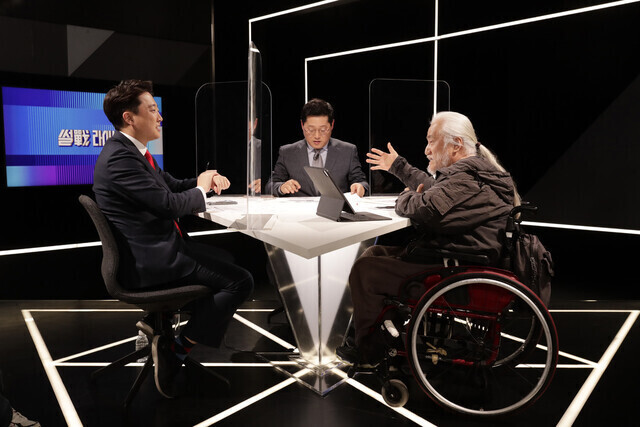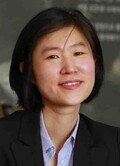hankyoreh
Links to other country sites 다른 나라 사이트 링크
[Column] Yong-jin’s guppies and disability rights in S. Korea


By Kim So-min, contributing writer
Kim Yong-jin has a fishbowl with guppies in his house. Jang Dong-hak, who used to live with Yong-jin at a facility for those with developmental disabilities called Doran Doran, also has a guppy bowl in his house. Last year, 18 people with grade 1-3 developmental disabilities, including Kim and Jang, were “deinstitutionalized” from the facility and were able to get things to fill their new homes. Guppies were apparently a popular choice.
Yong-jin now lives in a sunny two-room apartment in Seoul’s Bongcheon neighborhood. The house was made available through a public rental housing program run by the Korea Land & Housing Corporation. When I dropped by his home last May for a visit, he wasn’t home — he was at work, participating in the city's employment project for the disabled.
It was this house where social workers at the institution Kang Ja-yeong and Kim Kim-hwan, his friend Dong-hak, and Yong-jin’s father, and Yong-jin himself had gathered to create Doyak, a deinstitutionalization cooperative. Both 61-year-old Dong-hak and 35-year-old Yong-jin had been receiving 240 hours of personal assistance per month as well as housing services provided by the Seoul Metropolitan Government, but Doyak was put into motion to secure a community network as an extra layer of support for them.
Having never met a person with a developmental disability in my life, I could not imagine what their lives would look like. Would they be better off out here? Doran Doran was known as a relatively “good” facility.
After the deinstitutionalization process, it was difficult for the two men to adapt to having a home of their own, so it was quite common for them to call up the two social workers every morning. These social workers were practically on 24-hour standby, ready to help in any way they could.
I wondered if living in a facility wasn’t better or more comfortable for them.
“Well, would you want to live there?” Kang Ja-yeong asked me. No one had ever asked me such a thing before.
That day, Dong-hak took me out to lunch at a neighborhood kimchi jjigae restaurant. “I like it since it is my own place. I wish the grandma and her granddaughter living downstairs would stop fighting, though,” he told me.
It’s now been a full year since that day and the guppies are still thriving in Yong-jin’s house. Both Yong-jin and Dong-hak found work thanks to a Seoul public employment service for disabled people. In the mornings, they receive assistance with their breakfast and other tasks and when they go to work they receive help at the workplace too. They even have support staff come to their house after they finish work.
The cooperative has also started its work. Kang Ja-yeong says they mostly travel together to various places, including Jeju Island, Gangneung, and Mount Sobaek. Kang says it felt very freeing to go on these short trips together, but that nowadays Dong-hak and Yong-jin call much less often in the mornings.
It was difficult to make it this far, the two social workers fought a tough fight. The amount of time with assistants disabled people are entitled to is set by the National Health Insurance Corporation, but the limit is insufficient for serving the developmentally disabled. The two social workers tried hard to connect the two men with their local community.
Not only those who are disabled but also people without disabilities, myself included, depend on human connection to live.
On April 13, Lee Jun-seok, leader of the People Power Party, said in a debate with Park Kyeong-seok, leader of the Solidarity Against Disability Discrimination, that "59% of the disabled who can express their opinions said they want to stay in a facility,” adding that “deinstitutionalization is a matter of choice.”
But no one tells non-disabled people to choose between living at some facility or in society, since it is a natural right to live in society. This is why the right to live independently is specified in the UN Convention on the Rights of Persons with Disabilities, which South Korea ratified in 2008.
The participants of the survey cited by Lee had all lived at a facility for an average of 19 years. But if community welfare services had really worked, they would not have had to live there in the first place.
So was it really their choice to live in these facilities? Deinstitutionalization can be seen as a call to lay the groundwork for life in a society that 59% of those who “want” to remain in a facility have never even experienced before.
Those who have strengthened the community welfare services are not people like Lee Jun-seok, but people with severe disabilities who campaigned for deinstitutionalization at Marronnier Park in Seoul for 62 days in 2009 and social workers such as Kang Ja-young and Kim Chi-hwan, who have been standing at the forefront of the deinstitutionalization movement.
I don't know if the “civilized society” that Lee is talking about is a place where the basic rights of people are violated and where they have to face a seemingly never-ending wait for things to change. What I do know, however, is that I saw a “civilized society” in Yong-jin’s house, with his guppy bowl.
Please direct questions or comments to [english@hani.co.kr]

Editorial・opinion
![[Guest essay] The real reason Korea’s new right wants to dub Rhee a founding father [Guest essay] The real reason Korea’s new right wants to dub Rhee a founding father](https://flexible.img.hani.co.kr/flexible/normal/500/300/imgdb/original/2024/0423/8317138574257878.jpg) [Guest essay] The real reason Korea’s new right wants to dub Rhee a founding father
[Guest essay] The real reason Korea’s new right wants to dub Rhee a founding father![[Column] ‘Choson’: Is it time we start referring to N. Korea in its own terms? [Column] ‘Choson’: Is it time we start referring to N. Korea in its own terms?](https://flexible.img.hani.co.kr/flexible/normal/500/300/imgdb/original/2024/0423/3617138579390322.jpg) [Column] ‘Choson’: Is it time we start referring to N. Korea in its own terms?
[Column] ‘Choson’: Is it time we start referring to N. Korea in its own terms?- [Editorial] Japan’s rewriting of history with Korea has gone too far
- [Column] The president’s questionable capacity for dialogue
- [Column] Are chaebol firms just pizza pies for families to divvy up as they please?
- [Column] Has Korea, too, crossed the Rubicon on China?
- [Correspondent’s column] In Japan’s alliance with US, echoes of its past alliances with UK
- [Editorial] Does Yoon think the Korean public is wrong?
- [Editorial] As it bolsters its alliance with US, Japan must be accountable for past
- [Guest essay] Amending the Constitution is Yoon’s key to leaving office in public’s good graces
Most viewed articles
- 1[Guest essay] The real reason Korea’s new right wants to dub Rhee a founding father
- 2Terry Anderson, AP reporter who informed world of massacre in Gwangju, dies at 76
- 3[Column] ‘Choson’: Is it time we start referring to N. Korea in its own terms?
- 4Why Korea shouldn’t welcome Japan’s newly beefed up defense cooperation with US
- 5[Column] The clock is ticking for Korea’s first lady
- 6Opposition calls Yoon’s chief of staff appointment a ‘slap in the face’
- 7New AI-based translation tools make their way into everyday life in Korea
- 8[Editorial] Japan’s rewriting of history with Korea has gone too far
- 9[Reporter’s notebook] Did playing favorites with US, Japan fail to earn Yoon a G7 summit invite?
- 10[Column] The president’s questionable capacity for dialogue